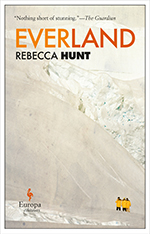 There’s something about Arctic and Antarctic adventure that stirs my interest. The merciless but fascinating environment, the odd fauna, the endurance, The Endurance, the way human frailties pop out against the stark backdrop. Evidently novelist Rebecca Hunt is subject to the same entrancement. She was one of 18 artists and writers who participated in the Arctic Circle residency in 2011, and I think it follows that the novel Everland resulted from that time. Everland, however, is set in the Antarctic, on an island off a cape of the continent (The island is named, in the first few sentences of Chapter 4, as “Everland.”). At first glance, the Arctic and the Antarctic could easily be traded for another, but in detail of course, they differ. Occasionally, small details betray this substitution of Hunt’s experience for the novel’s setting: the presence of “a pair of antlers” and a walrus skull on the exterior of the Antarctic scientific research base. Given the remoteness and expense of getting to Antarctica, it seems logical to presume these biological materials weren’t imported, and therefore the author may be mistakenly implying that they are found locally. However, there are no land mammals at all (much less hooved and antlered ones) on the continent of Antarctica. And the marine range of walruses is entirely limited to the Arctic and subarctic portions of the northern hemisphere.
There’s something about Arctic and Antarctic adventure that stirs my interest. The merciless but fascinating environment, the odd fauna, the endurance, The Endurance, the way human frailties pop out against the stark backdrop. Evidently novelist Rebecca Hunt is subject to the same entrancement. She was one of 18 artists and writers who participated in the Arctic Circle residency in 2011, and I think it follows that the novel Everland resulted from that time. Everland, however, is set in the Antarctic, on an island off a cape of the continent (The island is named, in the first few sentences of Chapter 4, as “Everland.”). At first glance, the Arctic and the Antarctic could easily be traded for another, but in detail of course, they differ. Occasionally, small details betray this substitution of Hunt’s experience for the novel’s setting: the presence of “a pair of antlers” and a walrus skull on the exterior of the Antarctic scientific research base. Given the remoteness and expense of getting to Antarctica, it seems logical to presume these biological materials weren’t imported, and therefore the author may be mistakenly implying that they are found locally. However, there are no land mammals at all (much less hooved and antlered ones) on the continent of Antarctica. And the marine range of walruses is entirely limited to the Arctic and subarctic portions of the northern hemisphere.
When it comes to geology, I’m sad to report that it gets worse: One character nominally has geological predilections, but the accompanying details betray the intent of conveying specialist knowledge:
He’d stockpiled Antarctic specimens, including diorite quartz and kenyte lava…
It seems to me that quartz and diorite are perhaps transposed in that sentence, or perhaps a comma is missing. Kenyte, on the other hand, is legit, and a common rock type associated with Mt. Erebus. So that’s a good example of a sentence that I can both critique and that taught me something I didn’t know.
Elsewhere:
‘Quartz feldspar, an igneous rock created from lava,’ he said to Millet-Bass, showing his latest discoveries. ‘That one’s pegmatite, another magma rock.’
Readers of this blog don’t need to be told that quartz and feldspar are two different minerals (or really, mineral families), and that putting them next to one another doesn’t constitute a rock name.
Hunt’s description of glaciation, however, is far superior to her petrology:
Everland’s glacier had bulldozed a deep, highway-wide gorge through the island. As the weight of countless tons of compacted snow chewed into the bedrock, the loose debris which piled at its edges had amassed into thirty-meter-high moraine walls. These moraines acted as benchmark, showing how much the glacier had receded in modern times. The ice that would have once filled the gorge was now a thinner, lower flow which had shrunk back from its former margins, like a drought-stricken river. An as the ice’s edges retreated, borders of dry ground between the moraine and each side of the glacier were exposed, inviting the curious to enter.
But that’s all I really had to work with on a strictly geological level. This is a novel, not a nonfiction account. It weaves a tale of twin expeditions beset by injury and fatigue in the same place, a century apart. Each expedition has three participants, all with their individual flaws and strengths. How the earlier, historical expedition is remembered (who’s a ‘bad guy’ and who’s a victim) doesn’t match the reality that unfolds over the course of the book. And while public opinion isn’t a factor in the more modern group working on the island, in some ways their story is more approachable, since two of the three are scientists, and another two of the three are field work fiends. The structure basically tells two stories simultaneously, as Cryptonomicon did, but with a simple, elegantly sculpted approach.
What Hunt does really well is think through social dynamics and elegantly express them on the page. The mental calculations made about how to say a given thing, to who, and with what emphasis and what consequences, were the parts that made the book really shine. These passages of social agonizing felt real in a way that I never could express myself, and I can forgive a lot of mineral/rock terminology swappage if it means I get such a clean, clear look at the human condition.
Overall: recommended.
